

Radiator Fan Orientation and Shroud Testing
Introduction
Welcome to my fan/shroud testing. Over time I've heard and seen a few experiements around fan orientation and shrouds, some that were conflicting with others and before I spend too much time testing more radiators, I figured it was time to put my own questions to test and see what I can find out about things like fans pushing vs pulling and shroud depth optimization.
First and formost since most users usually run just one set of fans and you can place them on either side of the radiator, there is always the question of which side? Do you install the fan on the side and "Push" air through the radiator, or do you put it on the back side and "Pull" air through like a vacuum? Users with experience with fans and dust buildup quickly realise that the hub in the center of the fan leaves a dead spot where very little air flows. You'll also notice that this dead spot is worse when a fan is pushing air vs. pulling air. Then there are shrouds, many people have reported worthwhile improvements to installing shrouds on the radiator, but I'm not sure there has been any clarity as to where the shrouds help or what depth is optimal.Before running these tests, I had always thought running fans in pull, and adding a shroud is best. Better yet would be two fans in pull. I based all of this on having witnessed the flow through the radiator being much more distributed in pull (Less hub effect) as well as the thought that removing the fan heat from getting into the radiator is also good benefit to pull. I had also heard from various forum sources that the best shroud depth would be several times the diameter of the hub to help straighten out the air flow. Well now that I had a radiator test bench setup, I figured it was time to put some of these ideas to some testing.
Before I go too far, I'd like to thanks the following sponsors for making this test possible with sample products to use.
Radiator = XSPC RS120
A special thanks to Paul from XSPC for providing me with an RS120 single radiator. The RS120 is an excellent radiator specifically designed for low speed fans (21mm thickness with approximately a 13.0 FPI fin density). I particularly wanted to do this tesing on a single radiator because it enables me to utilize more fans and shrouds to test with, and I would expect to see similar performance gains on other radiators as well.
Fans = Scythe Ultra Kaze
A special thanks to Linus from NCIX.com for providing me with the fans that were used in this testing.They provided me with both the Yate Loon D12SL12 slow speed 47cfm 120x25mm fans, as well as this Scythe Ultra Kaze DFS123812-3000 high speed 136cfm 120x38mm fans. Both fans present great value and a strong variety of cfm coverage for different setups.
Shrouds = The Feser Company (TFC) Shrouds
A special thanks to Martin from The Feser Company (TFC) for their new universal shround. I'm really excited about this shroud because for the first time we have a universal and stackable shroud that looks great and fits on any 120mm fan radiator, these are very impressive and sharp looking shrouds.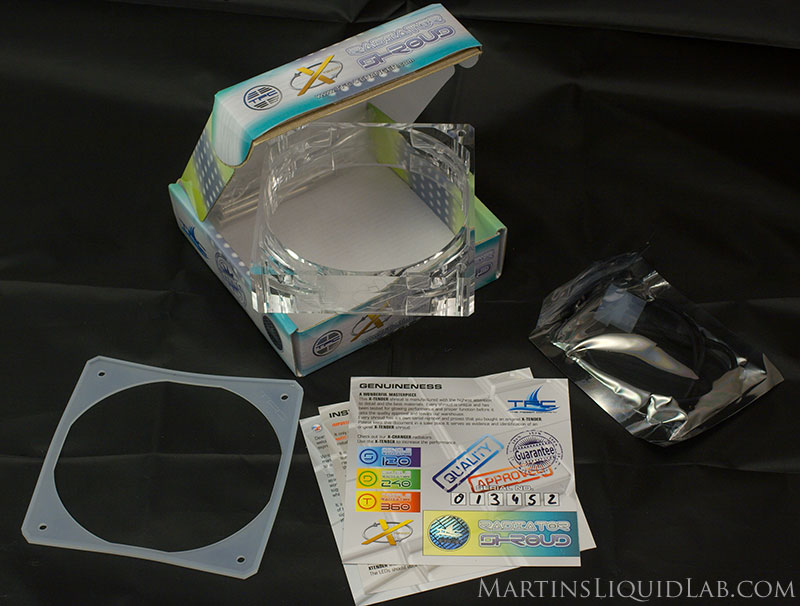
Testing Method
I utilized the same testing methodology as I do for my other radiator testing, you can refer to those details here under "Testing Specifications". The only thing I did differently is change the fans from my normal "Pull" to various push or pull or push/pull with different shroud depths. The heat load was kept constant using a 120V 3amp variac and dialing in one of my 300 watt water heaters to the desired amount of wattage. Fan RPM was held constant in all tests rather than voltage as I used my crystalfontz PWM controller which does a nice job at holding RPM very constant and easily controlled by a slider.So in the ead I did the same logging of temperatures for extended periods of time to average out constant recordings typically over a 30minute period after at least a 30 minute warm up time frame (90minutes for the first warm up). Then these tests were individually plotted to ensure stability in the delta temperature and averaged and summarized.
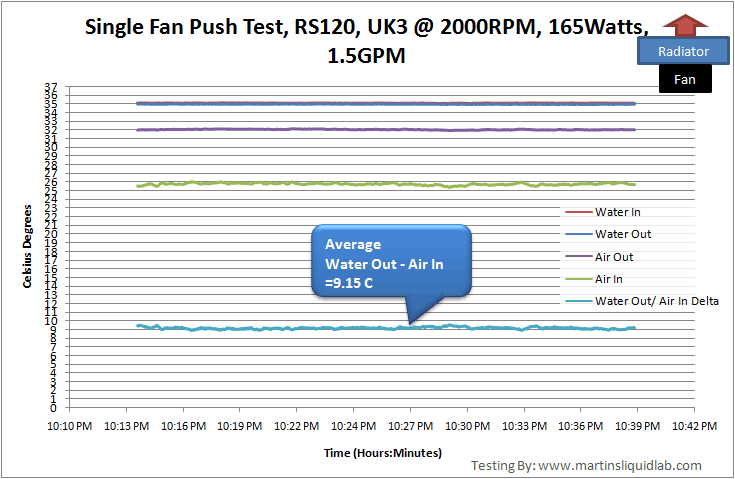
Test Results 38mm Single Fan, 2000RPM
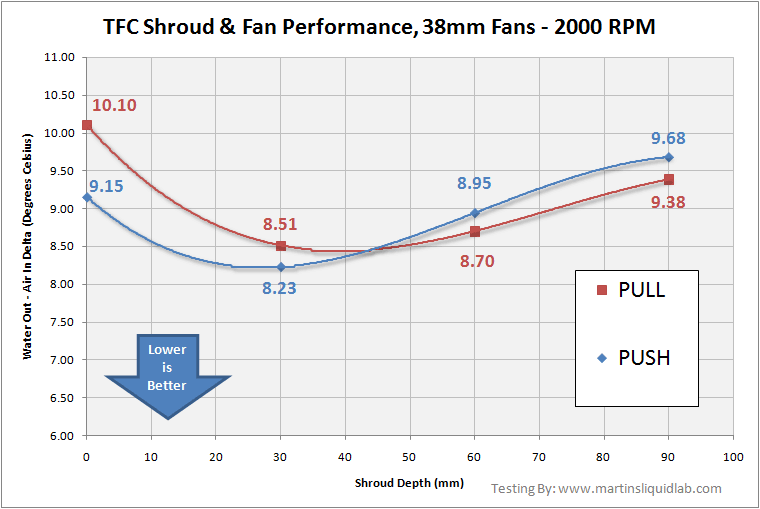
Now to take these results and compare relative to the worst case (Pull No Shroud) to get some percentages:
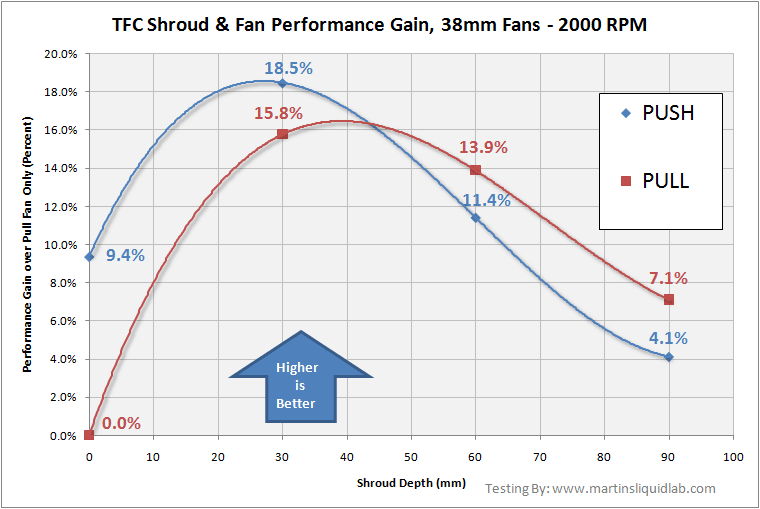
We gained over a single fan pull as shown above, nearly 18.5% using push with one TFC shroud vs pull no shroud.
Or for pull, almost 16% using the shroud in pull vs. pull without shroud...very nice!!
It also appears the shroud depth of 30mm is nearly optimal in both push and pull, this was obviously designed at this depth for good reason.
Conclusion for Single 38mm Fan - 2000 RPM
Push/Pull Update Single 38mm Fan - 2000 RPM
I have also finshed a little more testing with push/pull configurations with two fans. While I don't think very many people actually run fans on both sides, it's certainly an easy enough option. In the end, the push/pull configurations was as expected better than either push or pull with a single fan. In this scenario you gain the benefit of more fan pressure and result in an increased amount of flow rate. I even purposely adjusted the RPM of the fans to match 2000 again even though running push/pull will have a tendency to increse the fans RPM slightly at the same voltage. In addition I tested with shrouds again as well and found the single 30mm thickness to be ideal once again. You don't see quite the shroud gains as the single fan scenarios, but still a worthwhile improvement considering you also get lower noise. I found many folks have a hard time understand curve charts, so this time I broke it down into a basic bar chart with mini schematics of the fan setup to help clarify. Somewhat suprisingly, you nearly get 2 fan performance with a single fan plus shroud.
Push/Push and Pull/Pull Update Single 38mm Fan - 2000 RPM
I had this whacky idea that maybe running two fans on top of each other on either side would be another viable option, so I tested that. Push/Push came out at 9.1C, which is barely any better than just one fan in push. Pull/Pull came out at 8.9C which a little better, but still not worthwhile. Bottom line, if you want to run two fans, run one on either side of the radiator in a push/pull configuration.Push vs Pull vs Push/Shroud vs Pull/Shroud 25mm Fan - 1350 RPM
Now that we had the stronger and larger hub 38mm testing done, it was time to do a few quick tests to see if the trends continue with with slow speed fans.In order to keep water deltas down a bit, I turned the heat down arbitrarily to 150 watts total and proceeded and complete 4 more tests.
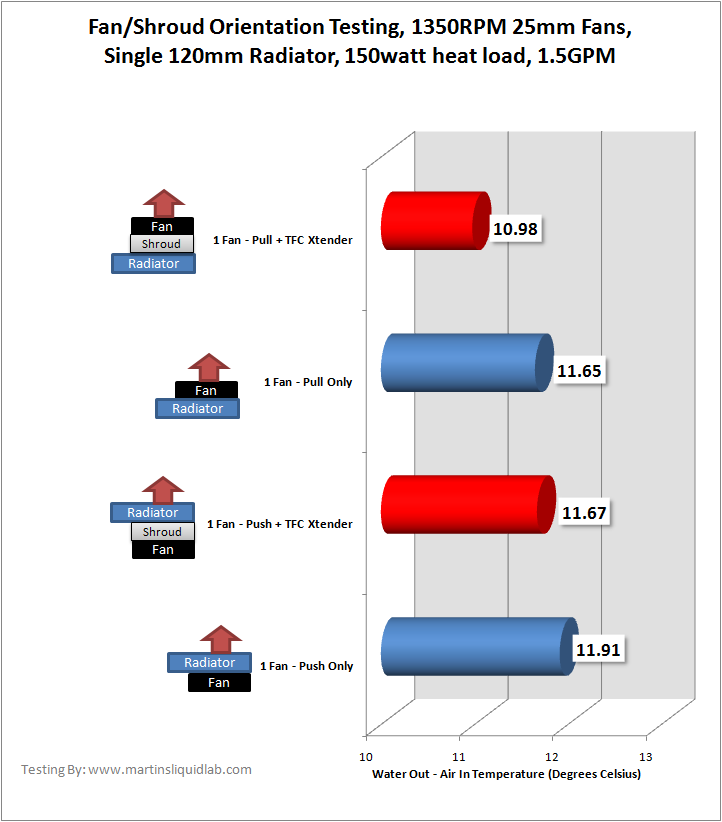
Push vs Pull has now changed places, but shrouds still continue to provide a good benefit, predominantly on the pull side similar to the larger gain in pull with the 38mm testing.
Bottom line
2 fans Push/Pull vs others - It was very clear that when using two fans per radiator section, that the radiator intself acts as a flow spreader and provided great benefit to straightening out the air for the second fan in a push/pull configuration. Just like doubling up with a pump, there is a pressure benefit to doubling up on fans and this translates to about a 20-30% performance gain. The added fan pressure simply means and added gain in air flow and corresponding performance. None of the experimental pull/pull or push/push configurations provided any noteworthy benefit as it seams the air is simply too disturbed from the first fan to allow the second to perform properly when air is moving. I would always recommend a push/pull configuration for two fans and add a shroud to both sides if space allows.
Testing Sponsors







